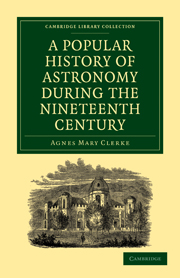Book contents
- Frontmatter
- PREFACE
- Contents
- INTRODUCTION
- Part I PROGRESS OF ASTRONOMY DURING THE FIRST HALF OF THE NINETEENTH CENTURY
- CHAPTER I FOUNDATION OF SIDEREAL ASTRONOMY
- CHAPTER II PROGRESS OF SIDEREAL ASTRONOMY
- CHAPTER III PROGRESS OF KNOWLEDGE REGARDING THE SUN
- CHAPTER IV PLANETARY DISCOVERIES
- CHAPTER V COMETS
- CHAPTER VI INSTRUMENTAL ADVANCES
- Part II RECENT PROGRESS OF ASTRONOMY
- INDEX
CHAPTER I - FOUNDATION OF SIDEREAL ASTRONOMY
Published online by Cambridge University Press: 07 September 2011
- Frontmatter
- PREFACE
- Contents
- INTRODUCTION
- Part I PROGRESS OF ASTRONOMY DURING THE FIRST HALF OF THE NINETEENTH CENTURY
- CHAPTER I FOUNDATION OF SIDEREAL ASTRONOMY
- CHAPTER II PROGRESS OF SIDEREAL ASTRONOMY
- CHAPTER III PROGRESS OF KNOWLEDGE REGARDING THE SUN
- CHAPTER IV PLANETARY DISCOVERIES
- CHAPTER V COMETS
- CHAPTER VI INSTRUMENTAL ADVANCES
- Part II RECENT PROGRESS OF ASTRONOMY
- INDEX
Summary
Until nearly a hundred years ago the stars were regarded by practical astronomers mainly as a number of convenient fixed points by which the motions of the various members of the solar system could be determined and compared. Their recognised function, in fact, was that of milestones on the great celestial highway traversed by the planets, as well as on the byeways of space occasionally pursued by comets. Not that curiosity as to their nature, and even conjecture as to their origin, were at any period absent. Both were from time to time powerfully stimulated by the appearance of startling novelties in a region described by philosophers as “incorruptible,” or exempt from change. The catalogue of Hipparchus probably, and certainly that of Tycho Brahe, some seventeen centuries later, owed each its origin to the temporary blaze of a new star. The general aspect of the skies was thus (however imperfectly) recorded from age to age, and with improved appliances the enumeration was rendered more and more accurate and complete; but the secrets of the stellar sphere remained inviolate.
In a qualified, though very real sense, Sir William Herschel may be called the Founder of Sidereal Astronomy. Before his time some curious facts had been noted, and some ingenious speculations hazarded, regarding the condition of the stars, but not even the rudiments of systematic knowledge had been acquired. The facts ascertained can be summed up in a very few sentences.
- Type
- Chapter
- Information
- Publisher: Cambridge University PressPrint publication year: 2010First published in: 1885



